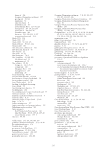Lake Eyre Basin Rivers 214 I address the legal context of the debate over the Wild Rivers declarations over the three main river systems in the Lake Eyre Basin: Cooper Creek, the Georgina River and Diamantina River (the Western Rivers Fig. 21.1). I examine the main strengths and weaknesses of their management regimes in relation to land and water. I also review how the views communicated by people were considered, and examine some of the options available. I contrast this with the lack of transparency in water management decisions in the Lower Balonne system, Queensland in the 1980s and 1990s, which have affected environmental health and livelihoods in that region (see Chapters 14 and 15). Significant legislative and policy documents Important water law and policy developments have occurred at the national and state levels, over the last 25 years: 1989–2014 (Table 21.1 see Chapters 7 and 20). This has paralleled the initiatives of the Lake Eyre Basin community to manage and protect the Basin’s land and water resources. The Queensland department responsible for water management has changed many times over this period. In 1989, it was the Queensland Water Commission, but the water portfolio came under the authority of the Department of Environment and Resource Management in 2012. After the 2012 state election, river management responsibilities changed – wild rivers and environmental protection responsibilities went to the Department of Environmental and Heritage Protection while water planning, including environmental flow responsibilities were with the newly formed Department of Natural Resources and Mines. For simplicity, I refer to the relevant water agency as ‘the Department’. Fig. 21.1. Concern over the future of rivers of the Lake Eyre Basin, including their waterholes (such as Pulchera waterhole here on the Mulligan River in the Georgina River catchment) and floodplains has an ongoing presence, particularly in relation to water resource management and most recently, mining development and exploration (photo, A. Emmott).
Downloaded from CSIRO with access from at 216.73.216.176 on Nov 27, 2025, 5:07 AM. (c) CSIRO Publishing

















































































































































































































































































